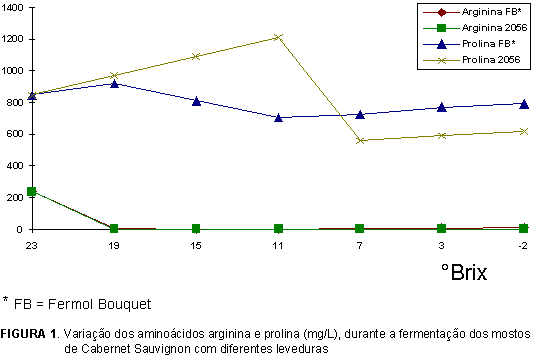The main aim of the fermentation of Cabernet Sauvignon Musts with different yeasts was the analysis of aminoacids and urea. The grape was chosen because its high proline and low arginine content.The grapes were harvested and crushed at the Almadén vineyard located in Santana do Livramento, RS, Brasil; the musts were transported to the Federal University of Santa Maria, Department of Food Science, where they were divided in two lots to which were added Saccharomyces cerevisiae Fermol Bouquet and Saccharomyces cerevisiae 2056. The analysis of the aminoacids was done using a Hitachi L-8500 aminoacid analyzer according to SANDERS and OUGH (21) and urea according ALMY and OUGH (1) modified by PEREIRA and DAUDT (19). Proline was found in the highest amount (847mg/l) followed by arginine (235mg/l) and alanine (87mg/l). The majority of the aminoacids fraction was used at the beginning of the fermentation with the exception of proline; this fact enfasized the low preference, by these yeasts, for this aminoacid. The aminoacids arginine, threonine, serine, aspartate and isoleucine can be considered better sources of nitrogen to the yeasts. The maximum excretion of urea in the must ocurred, with both yeasts, at the maximum arginine consumption, 2.7mg/l with the yeast 2056 at 19°Brix and 4.1mg/l with the yeast Fermol Bouquet at 15°Brix.
amino acids; urea; must; fermentation; wine




